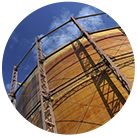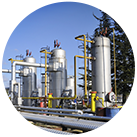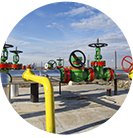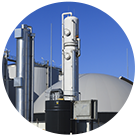 |
|
|
|
OptiPEAK TDL600 - Moisture in Natural Gas Analyzer |
|
|
|
You need Flash player 8+ and JavaScript enabled to view this video.
|
 |  |  |  |  |
| Gas Storage | Transmission | Dehydration | Custody Transfer | Biomethane |
| | The next generation TDLAS moisture in natural gas analyzer |
OptiPEAK TDL600
Fast, precise and accurate moisture measurements in natural gas with minimal maintenance and low life-time cost.
The OptiPEAK TDL600 from Michell Instruments uses the latest developments in Tuneable Diode Laser Absorption Spectroscopy to enable accurate moisture measurements even in changing background compositions of natural gas. This high performance moisture analyzer offers reliability, ease of use, a small footprint and will provide low cost of ownership.
Performance
The OptiPEAK offers high accuracy with a class-leading lower detection limit of <1 ppmV. Dynamic background compensation – D-MET – automatically copes with changes in methane levels in the gas mixture. The OptiPEAK comes ready to cope with gas from non-conventional sources, such as shale gas or bio-methane.
Reliability
High-accuracy temperature control provides the highest measurement integrity at all times, while continuous laser optimization results in no drift in the signal, ensuring long-term accuracy.
Simplicity
Designed for easy integration into existing control rooms, the OptiPEAK TDL has an integrated sampling system and an easy-to-use Human Machine Interface (HMI). A touch-screen interface means that no Hot Work permit is required.
Reduced cost of ownership
Minimum installation and maintenance along with the built-in self verification give the OptiPEAK a low life-time cost of ownership.
|
| Natural Gas StorageTop |
 There are many reasons for storing natural gas. The timescales taken to find, process and transport gas are very different to the timescales for delivery and consumption. Gas may be produced before it is needed or demand may suddenly be greater than supply, or technical issues may restrict supply in the network. Gas storage can assist in managing these load variations.
There are many reasons for storing natural gas. The timescales taken to find, process and transport gas are very different to the timescales for delivery and consumption. Gas may be produced before it is needed or demand may suddenly be greater than supply, or technical issues may restrict supply in the network. Gas storage can assist in managing these load variations.
There are various methods for storing natural gas. The three most common methods being underground storage in depleted gas reservoirs, aquifers or salt caverns. Each has its own advantages, but all have common requirements in terms of the quality of gas injected and extracted from the facility. Having the ability to quickly tap into previously stored capacity provides both economic and strategic advantages, but can cause issues in correctly monitoring the quality of the extracted gas. There is an obvious need for fast responding instrumentation in order to ensure the requirements of the main international natural gas quality harmonization guidelines are not exceeded. The OptiPEAK TDL600 can respond in seconds and provide class leading accuracy of measurement to support the rapid ramp-up in gas supply from the storage facility into the network.
The OptiPEAK TDL600 utilizes the innovative D-MET System, dynamic background gas compensation. For the user, this means that the moisture measurement is virtually independent of changes in the methane level. No further manual correction factors are required.
|
| Natural Gas Transmission & Custody TransferTop |
 Raw natural gas varies substantially in composition from source to source. Methane is always the major component, typically comprising 60% to 98% of the total. Additionally, natural gas contains significant amounts of ethane, some propane and butane, and typically 1% to 3% of other heavier hydrocarbons. Natural gas often contains associated and undesirable impurities, such as water, carbon dioxide, nitrogen, and hydrogen sulphide. Although the composition of raw gas varies widely, the composition of gas delivered to commercial pipeline grids is tightly controlled.
In order for the gas producers to meet pipeline specifications, all natural gas requires some treatment even if all that is done is to remove bulk water. Around a fifth of gas extracted requires extensive, and often expensive, treatment, before it can be delivered to the pipeline.
Raw natural gas varies substantially in composition from source to source. Methane is always the major component, typically comprising 60% to 98% of the total. Additionally, natural gas contains significant amounts of ethane, some propane and butane, and typically 1% to 3% of other heavier hydrocarbons. Natural gas often contains associated and undesirable impurities, such as water, carbon dioxide, nitrogen, and hydrogen sulphide. Although the composition of raw gas varies widely, the composition of gas delivered to commercial pipeline grids is tightly controlled.
In order for the gas producers to meet pipeline specifications, all natural gas requires some treatment even if all that is done is to remove bulk water. Around a fifth of gas extracted requires extensive, and often expensive, treatment, before it can be delivered to the pipeline.
These pipeline networks are highly complex transmission and distribution systems used to move gas across states, countries or even continents. As an example, the US natural gas network consists of more than 210 natural gas pipeline systems, 305,000 miles of interstate and intrastate transmission pipelines, more than 1,400 compressor stations and 49 locations where natural gas can be imported/exported via pipelines. In Europe, gas is commonly moved between countries and a large amount (~30%) is imported from Russia. In all of these cases it is important that gas quality is maintained within the requirements of the main international natural gas quality harmonization guidelines. These guidelines include moisture content and in Europe, the EASEE-gas Common Business Practice – 2005-001/01 – Harmonisation of Natural Gas Quality sets a water dew-point limit of -8°C at 70 barg (-45°F at 1015 psig) or ~49 ppmV.
It is therefore important that, in order to satisfy fiscal contractual obligations to ensure that the gas is safe to transport and has the right properties for subsequent use, fast and accurate online moisture measurements are carried out. This applies equally to transmission networks, custody transfer and gas export pipelines.
The OptiPEAK TDL600 Process Moisture Analyzer offers high accuracy with a class-leading lower detection limit of <1 ppmV. Dynamic background compensation – D-MET – automatically copes with changes in methane levels in the gas mixture. The OptiPEAK comes ready to cope with gas from non-conventional sources, such as shale gas or biomethane.
|
| Natural Gas DehydrationTop |
 Most natural gas treatments involves the removal of solids, free liquids and the reduction of water vapor content to acceptable levels (typically to 7lbs water/mmscf or less), all done before the gas enters the transmission pipeline system.
Most natural gas treatments involves the removal of solids, free liquids and the reduction of water vapor content to acceptable levels (typically to 7lbs water/mmscf or less), all done before the gas enters the transmission pipeline system.
Liquid phase or free water can be removed using multi-stage separators but the presence of water vapor requires that natural gas be subjected to a dehydration process. There are various methods of dehydration, but the most common and cost effective method for removing water from produced gas is the use of a liquid desiccant, namely glycol. Triethylene glycol is the most common desiccant, mainly due to its low vaporization losses and ease of regeneration.
This glycol absorber or contactor process is well established and understood but it is still possible for process issues, such as excessive gas velocities through the contactor, which can allow glycol to be carried out of the top of the column with the dry natural gas stream. This has the effect of increasing glycol losses in the process, but can also have a detrimental effect on downstream moisture analyzers. Any moisture sensors which are based on a metal-oxide capacitive/impedance sensor technology are susceptible to the effects of high dielectric constant of glycols. Exposure of these types of sensor to glycol carryover will mean inaccurate or even full scale wet readings.
Obviously, the application of a non-contact measurement technology such as TDLAS completely removes the risk of glycol contamination of the sensor. The OptiPEAK TDL600 Tuneable Diode Laser Analyzer employs the latest techniques in laser absorption spectroscopy and signal processing power to offer a robust high performance analyzer, designed specifically for the measurement of moisture in natural gas. This non-contact technology requires minimal maintenance, even in demanding applications such as changing methane concentrations or sour gas. The analyzer is fully hazardous area certified and delivers class-leading measurement performance, stability and detection sensitivity.
|
| BiomethaneTop |
 There is an increasing worldwide movement to increase the use of renewable energy sources. One of those initiatives is the development of the use of biogas. Driven by projects like the IEA Bioenergy Task 37: Energy from biogas and landfill gas and the US Environmental Protection Agency‘s AgStar, there has been a large increase in biogas production.
There is an increasing worldwide movement to increase the use of renewable energy sources. One of those initiatives is the development of the use of biogas. Driven by projects like the IEA Bioenergy Task 37: Energy from biogas and landfill gas and the US Environmental Protection Agency‘s AgStar, there has been a large increase in biogas production.
Biogas typically refers to a mixture of gases produced by the breakdown of organic matter, most commonly by anaerobic digestion. These digesters can be fed with biodegradable wastes such as sewage sludge and food waste or specially grown energy crops such as maize. Raw biogas produced in this way is typically 50-75% methane and 25-50% CO2 and can either be used as fuel gas for a Combined Heat & Power (CHP) unit or can be further processed or upgraded into biomethane and injected into the natural gas grid.
Variations in production and processing can mean variation in gas quality and fast, accurate measurement of that quality prior to injection into the grid is key to maintaining network gas quality. The very fact that the methane content varies can cause problems for older TDLAS designs. These multiple, variable components can cause problems with the moisture measurement as spectral interference becomes apparent and this means loss of accuracy in the analyzer.
To compensate for the effects of variable composition in the gas stream properly, we need to measure those components. For example, the concentration of methane can be measured directly by tuning the laser to a nearby methane absorption peak (with no water interference) and making a separate secondary measurement. In its simplest form, the absorption due to the variable methane can then be subtracted from the moisture giving a fundamental “clean” detection.
The OptiPEAK TDL600 utilizes the innovative D-MET System, dynamic background gas compensation. For the user, this means that the moisture measurement is virtually independent of changes in the methane level. No further manual correction factors are required, guaranteeing class leading performance in the real world of varying Natural Gas compositions.
|
| ©Michell
Instruments. Privacy Policy | Cookies |
Dew-Point, Humidity, Oxygen |
|